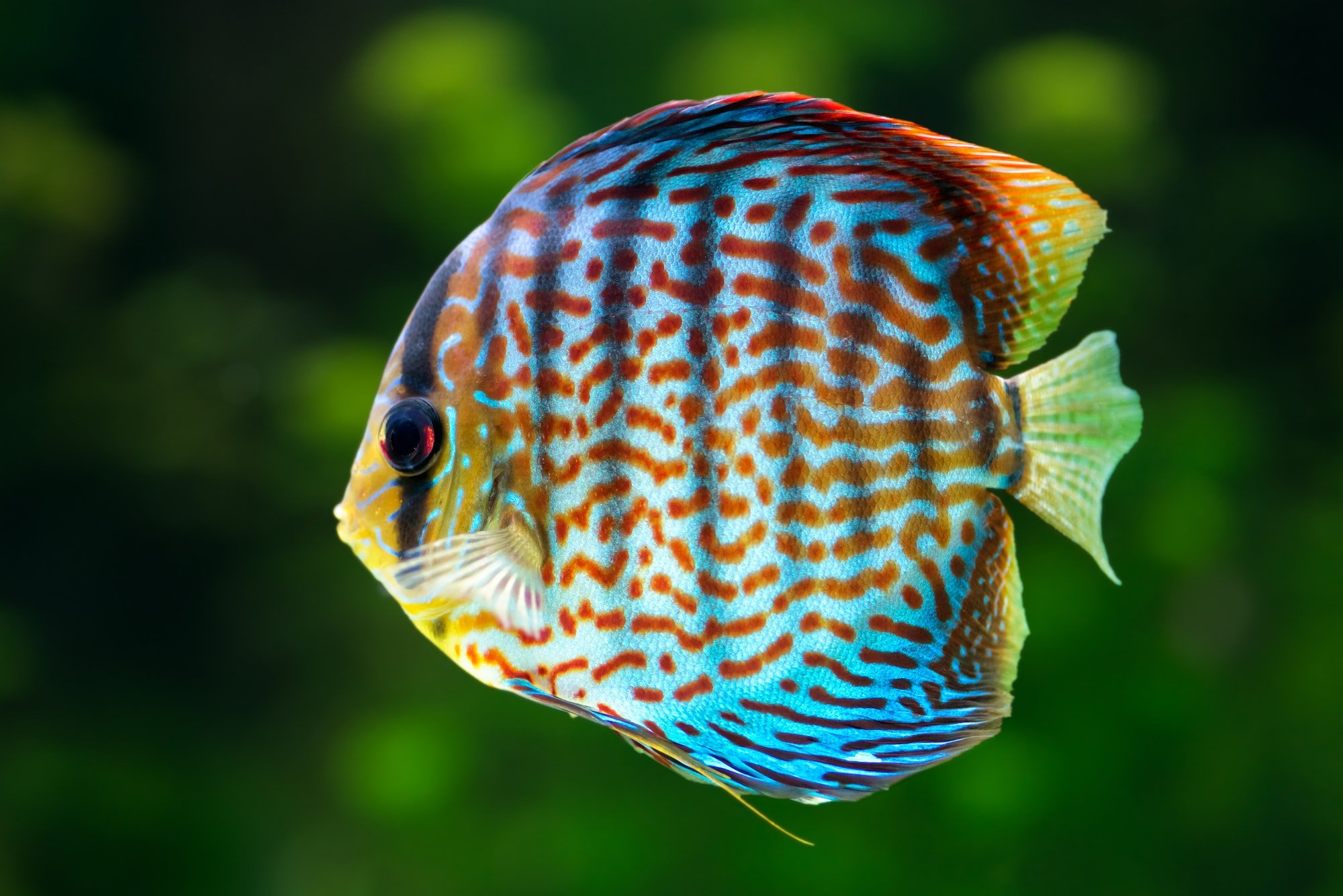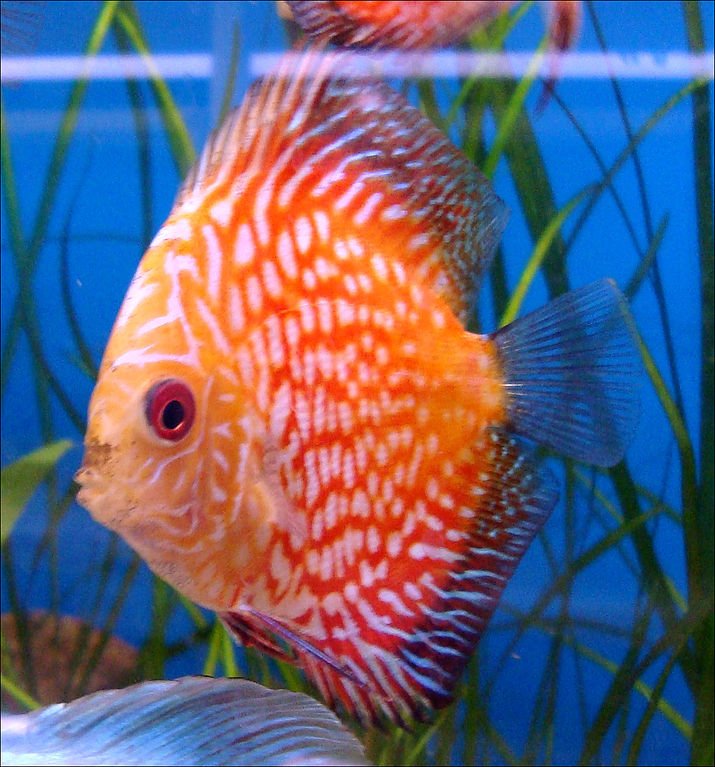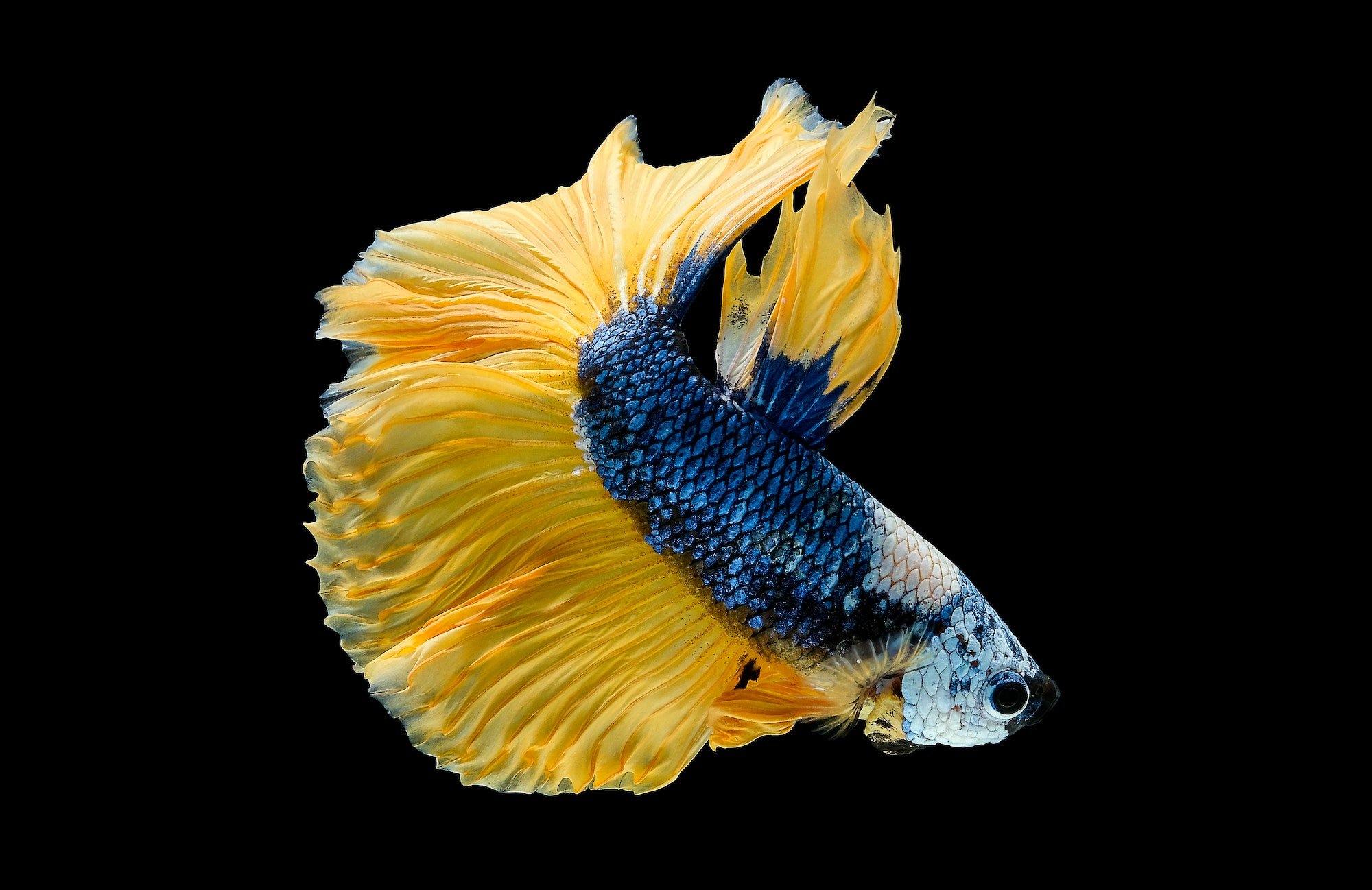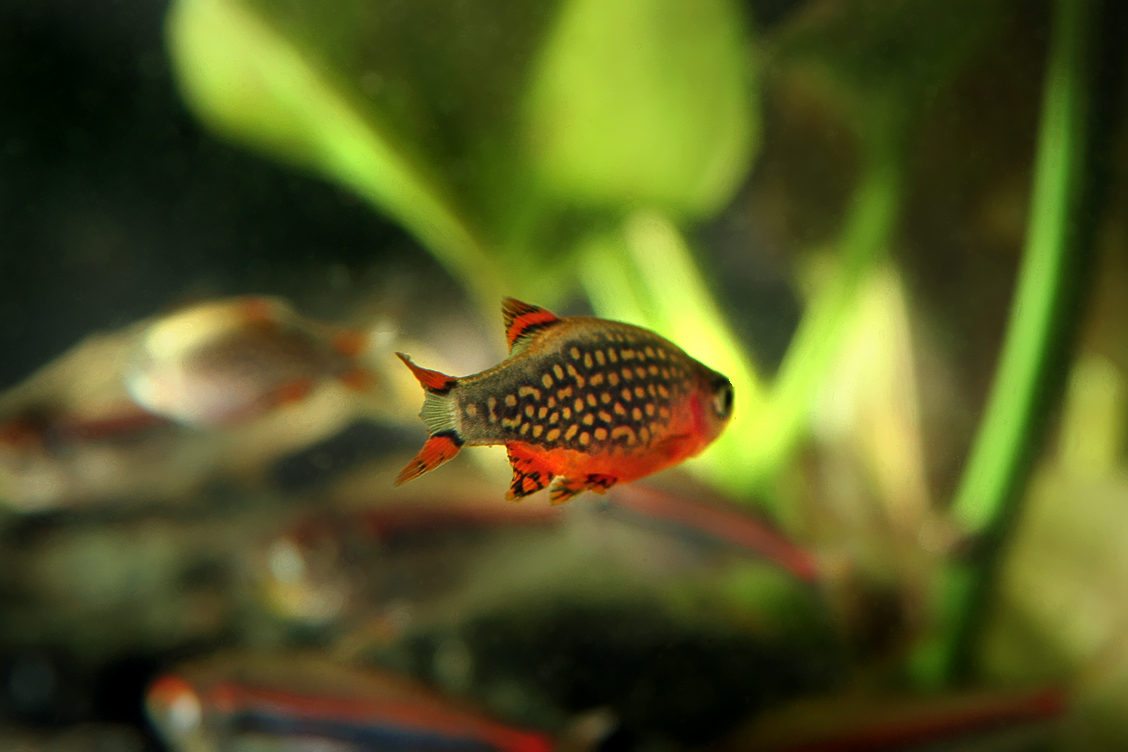If you’re an aquarium enthusiast, you’ve likely heard about the Discus fish, scientifically known as Symphysodon. This vibrant and majestic creature is a true gem in the world of aquatics. With their unique shape and stunning array of colors, Discus fish is a sight to behold and a joy to care for.
Discus fish hail from the Amazon River basin in South America. They belong to the Cichlidae family, which includes other popular aquarium fish like angelfish and Oscars. There are three species of Discus fish: Symphysodon aequifasciatus, Symphysodon discus, and Symphysodon tarzoo. Each species boasts a unique color pattern, making them a captivating addition to any aquarium.
Despite their exotic origins, Discus fish have found popularity worldwide. They’re not considered rare, but they do command a higher price point due to their specific care requirements. This has led to them being seen as luxury fish, a status symbol for many aquarium owners. But don’t let this intimidate you. With the right knowledge and care, anyone can enjoy the beauty of Discus fish in their home.
Discus fish are more than just pretty faces. They have some fascinating facts that make them even more interesting. For instance, did you know that both parents care for their eggs and fry? They even produce mucus on their bodies that the fry can eat. Talk about dedicated parenting!
And if that wasn’t enough, Discus fish are also known for their peaceful and social behavior. They’re typically mid-dwellers, preferring to stay in the middle of the water column. They’re also omnivores, enjoying a diet of algae, small invertebrates, and fish fry in the wild. In captivity, they often eat high-quality flake food, pellets, and frozen or live foods.
The history of Discus fish in aquariums dates back to the early 20th century. They were first scientifically described by Johann Jacob Heckel in 1840. Since then, they’ve been gracing aquariums worldwide, bringing joy and beauty to those lucky enough to care for them. So, if you’re considering adding a Discus fish to your aquarium, you’re in for a treat. With their vibrant colors, unique behaviors, and fascinating history, Discus fish truly are the king of the aquarium.
Table of Contents
Unveiling the Discus Fish: Price, Common Names, and Dazzling Variants
Discus fish are a popular choice for aquarium enthusiasts due to their striking colors and unique shape. However, their price, common names, and the variety of variants available can vary significantly. Here’s a detailed look at these aspects:
Price
The price of Discus fish can vary widely based on factors such as their size, color, variant, and whether they are wild-caught or bred in captivity. On average, you can expect to pay anywhere from $30 to $100 for a juvenile Discus fish. Adult Discus fish, particularly those with rare colors or patterns, can cost several hundred dollars.
List of Variants
There are numerous variants of Discus fish, many of which have been selectively bred for their unique colors and patterns. Some of the most popular include:
Blue Discus
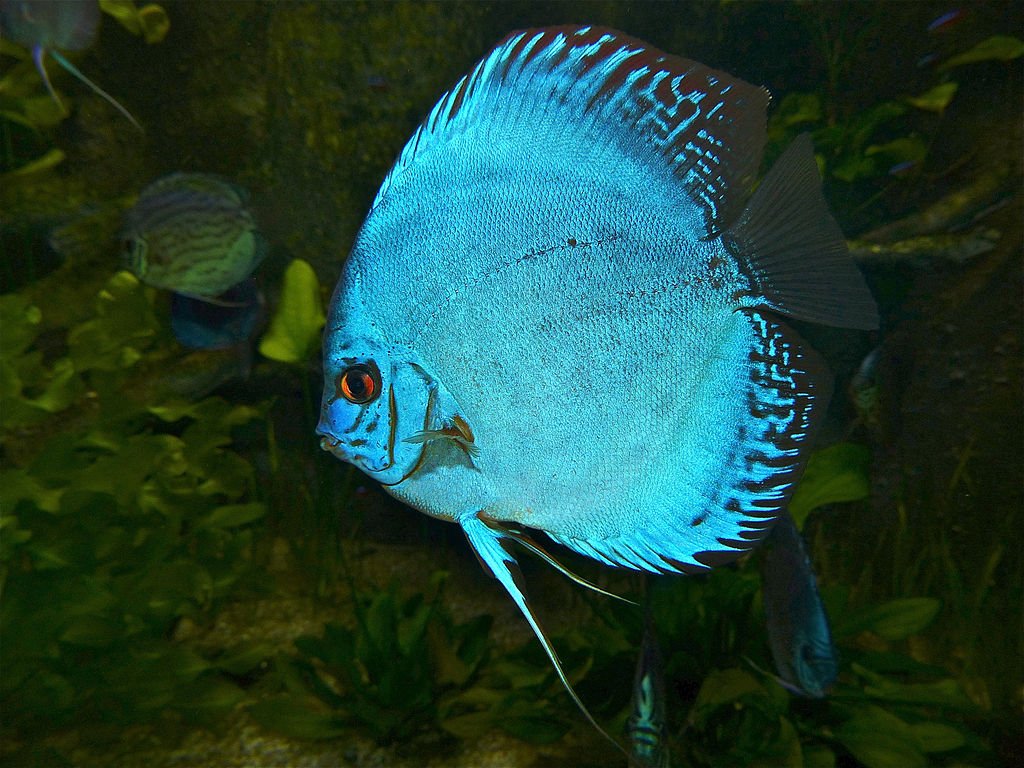
This variant is known for its stunning shades of blue. The color can range from light, sky-blue to a deep, electric blue. The intensity of the color can change based on the fish’s mood and health.
Red Discus
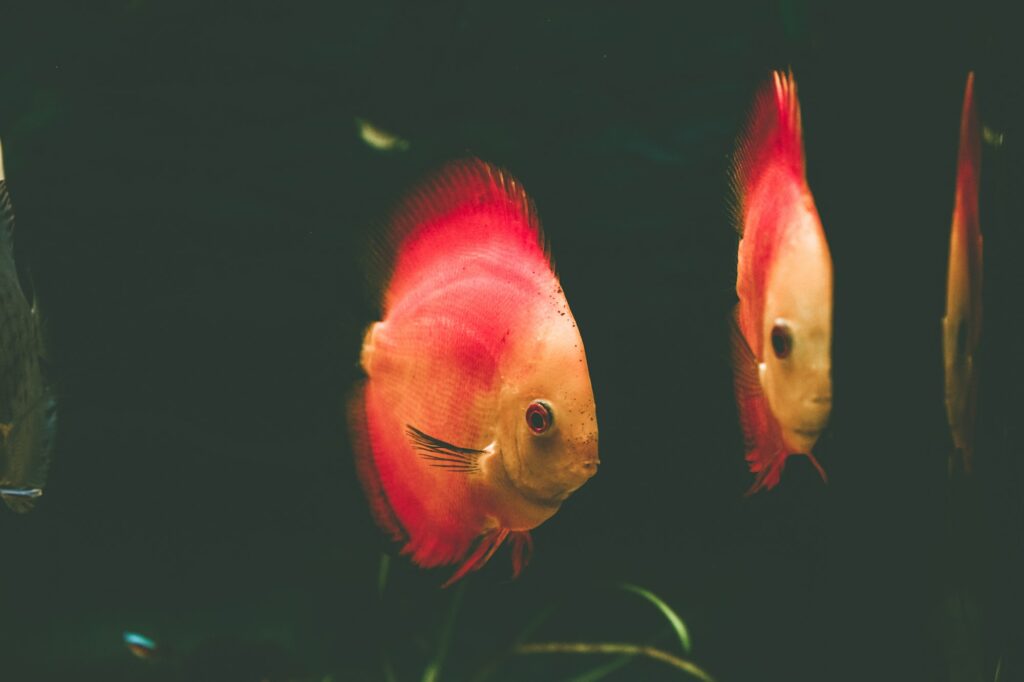
The Red Discus is prized for its vibrant red coloration. The hue can range from a bright, fiery red to a deeper, burgundy shade. This variant often features contrasting patterns in different shades of red.
Green Discus
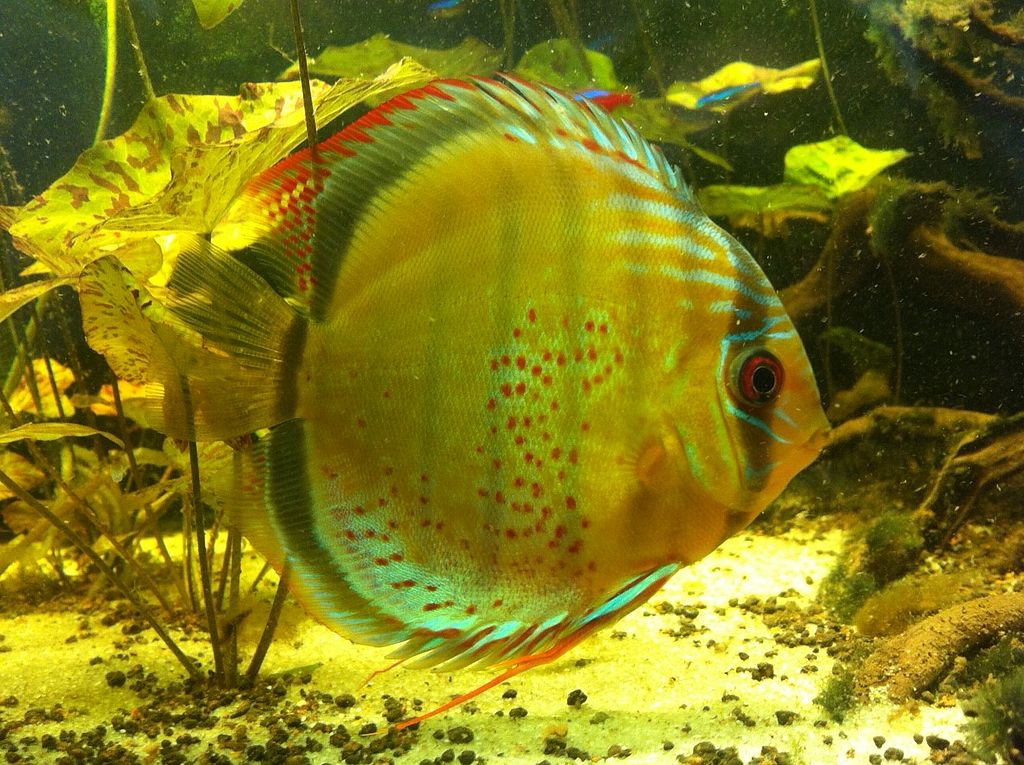
The Green Discus is a unique blend of green and blue hues. The green can range from a light, grassy color to a deep, emerald green. This variant often has a marbled or spotted pattern that enhances its beauty.
Golden Discus
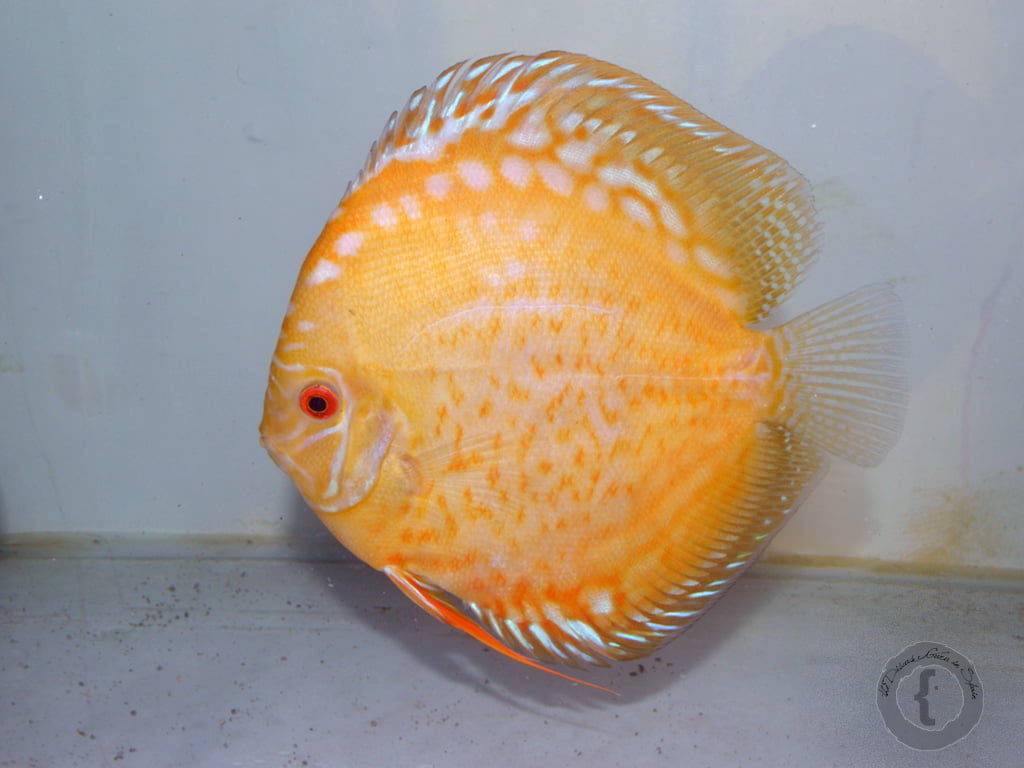
The Golden Discus is known for its beautiful golden color. This variant can range from a light, yellow-gold to a deep, rich gold. The Golden Discus often has a contrasting pattern that makes its golden color stand out even more.
Spotted Discus
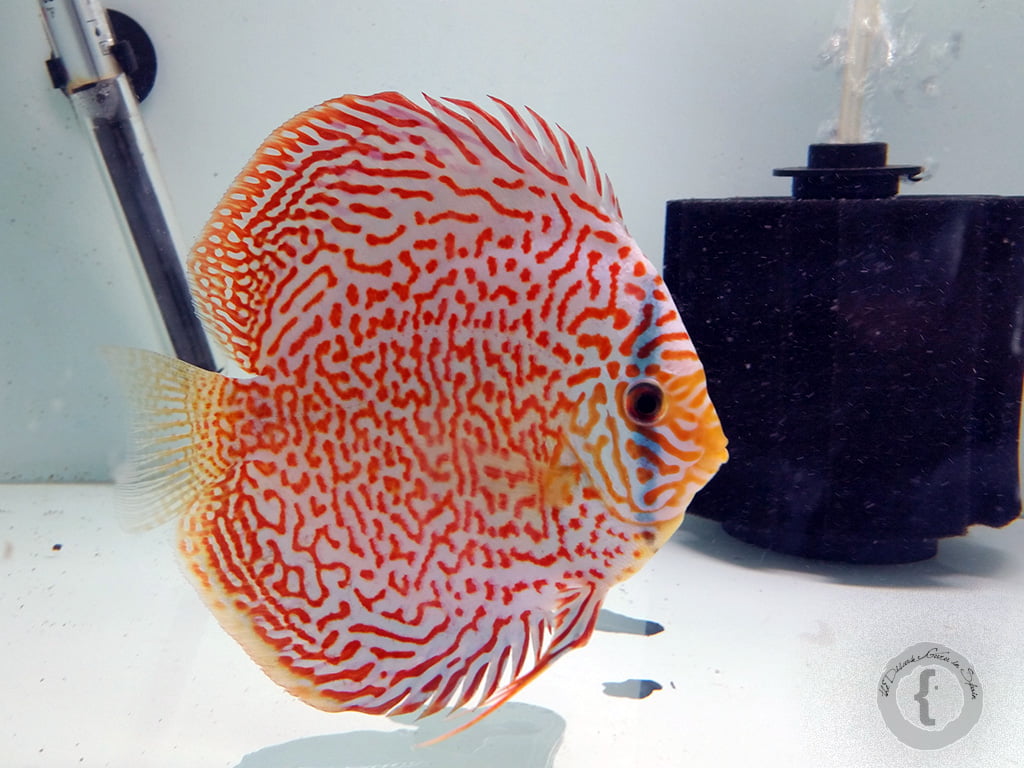
The Spotted Discus is known for its distinctive spotted patterns. The spots can vary in color, including blue, red, and black. The pattern can cover the entire body of the fish or be concentrated in certain areas.
Striped Discus
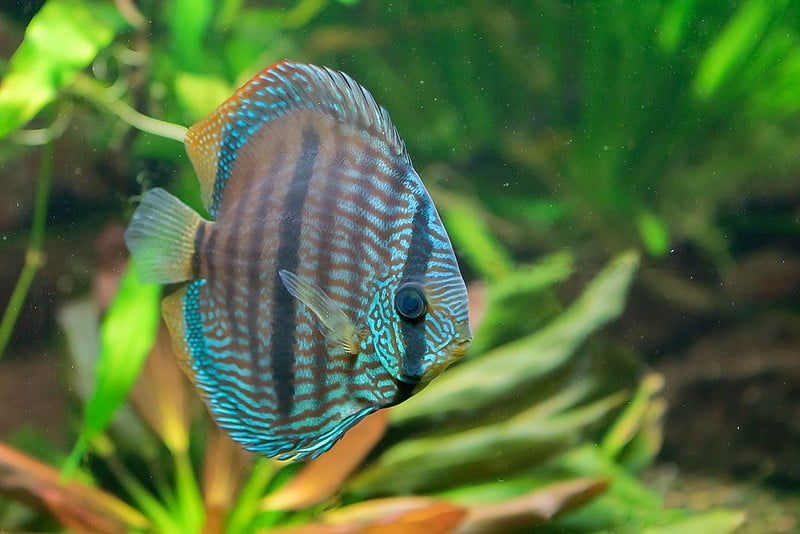
The Striped Discus is characterized by its vertical stripes. The stripes can be of various colors, often contrasting with the base color of the fish. This pattern gives the Striped Discus a unique and striking appearance.
White Discus
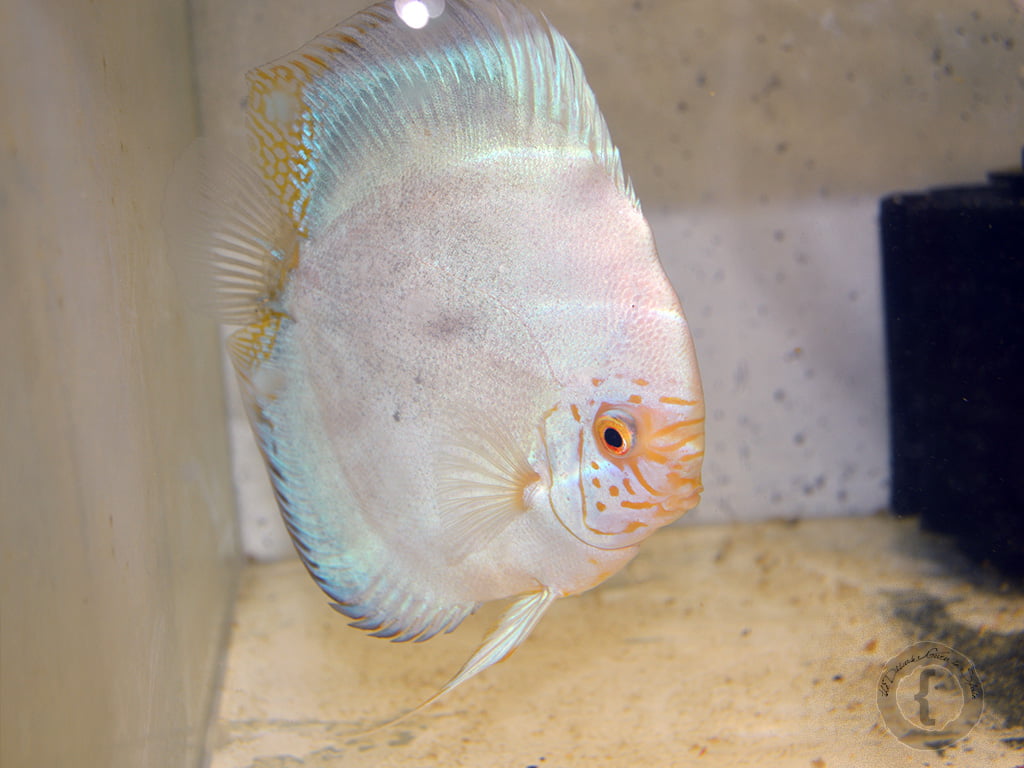
The White Discus is known for its pure, snowy white color. This variant is often sought after for its unique color, which stands out in any aquarium.
Checkerboard Discus
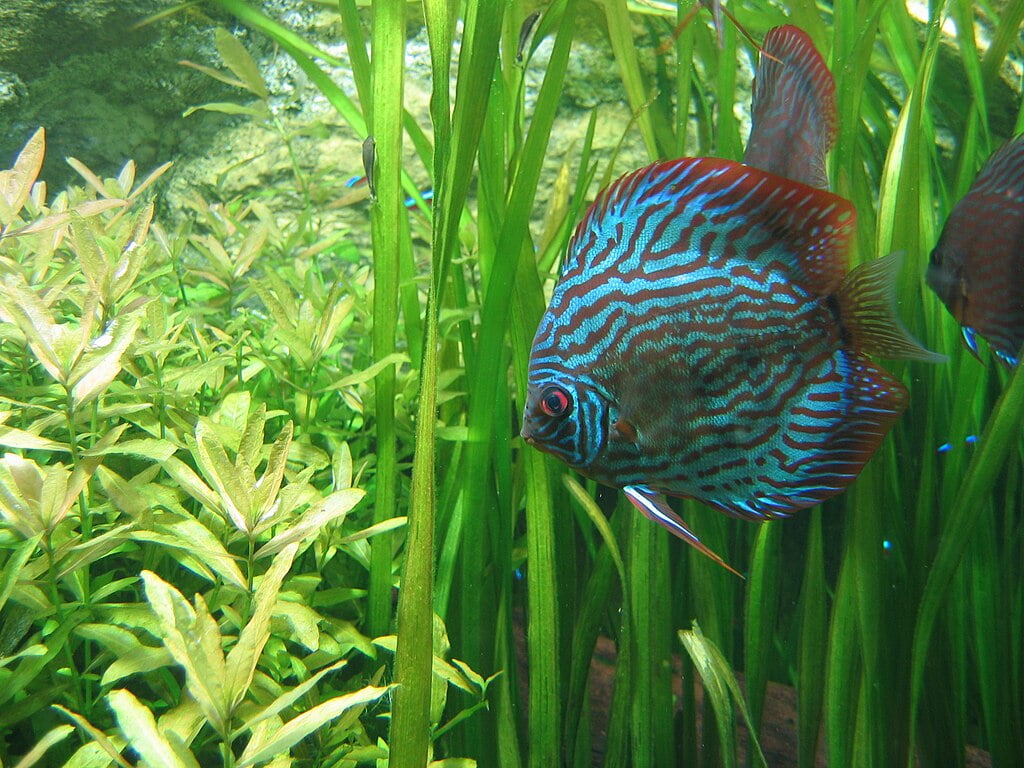
The Checkerboard Discus has a unique pattern that resembles a checkerboard. This variant can come in a variety of colors, with the checkerboard pattern often in a contrasting color.
Pigeon Blood Discus
The Pigeon Blood Discus is known for its bright red-orange color, interspersed with small, pepper-like spots. This variant is one of the most popular and recognizable among Discus enthusiasts.
Turquoise Discus
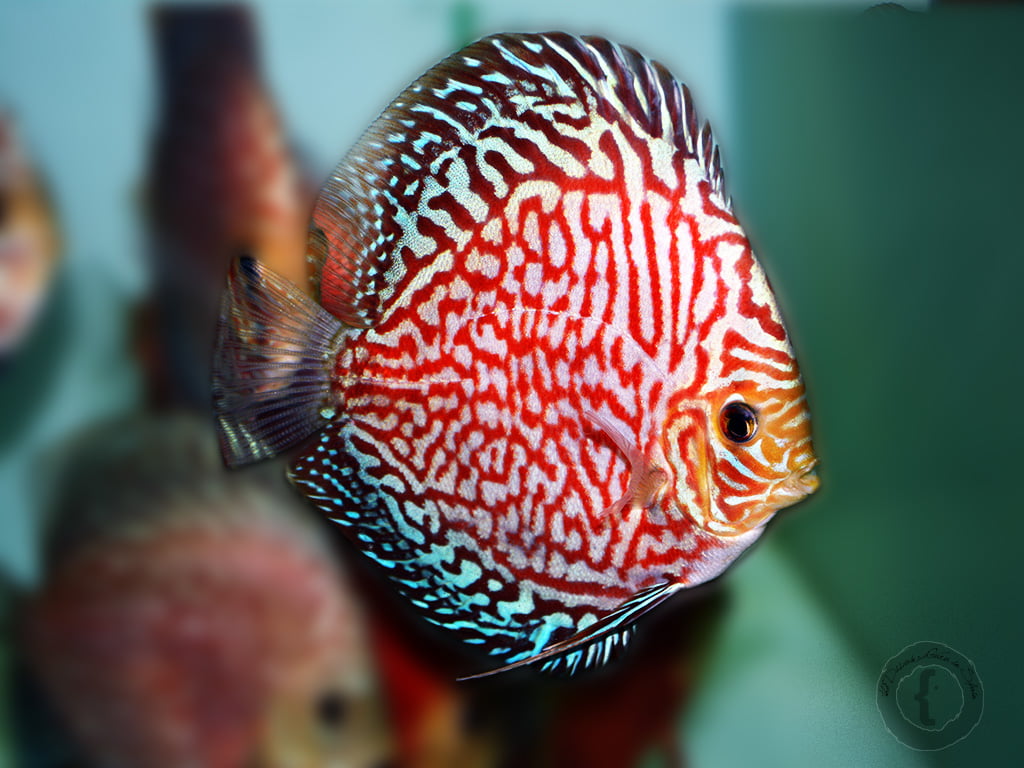
The Turquoise Discus is characterized by its beautiful blend of blue and green colors, giving it a turquoise appearance. This variant often has a pattern that enhances its stunning coloration.
The Ideal Home: Discus Fish Tank Size and Water Parameters
Creating the perfect environment for your Discus fish is crucial for their health and happiness. Here’s a detailed look at the ideal tank size and water parameters for Discus fish:
Tank Size
- Minimum Size: The minimum recommended tank size for Discus fish is 55 gallons for a pair. These fish can grow up to 5-6 inches in captivity, and they need plenty of space to swim and explore.
- Group Size: If you plan to keep a group of Discus fish, you’ll need a larger tank. A good rule of thumb is to add an additional 10 gallons for each additional Discus fish. For example, a group of five Discus fish would require a tank of at least 85 gallons.
Water Parameters
- Temperature: Discus fish prefer warm water. The ideal temperature range for these fish is between 82 and 86 degrees Fahrenheit (28-30 degrees Celsius).
- pH Level: Discus fish prefer slightly acidic water. The ideal pH range for these fish is between 6.0 and 7.0.
- Hardness: The water hardness should be between 1 and 4 dGH (degrees of general hardness).
- Water Change: Regular water changes are crucial for maintaining the health of your Discus fish. It’s recommended to change 25-50% of the water weekly.
- Filtration: Discus fish require clean water to thrive. A high-quality filtration system is essential to remove waste and toxins from the water.
Maintaining the right tank size and water parameters is crucial for the health and well-being of your Discus fish. Regular monitoring and adjustments can ensure your Discus fish have a comfortable and healthy environment to thrive in.
Discus Fish Lifespan and Full Size
Understanding the lifespan and full size of Discus fish is essential for providing them with the best care. Here’s a detailed look at these aspects:
Lifespan
- In Captivity: With proper care, Discus fish can live for 10 to 15 years in captivity. This lifespan can be extended with optimal living conditions, including a well-maintained tank, a balanced diet, and regular health check-ups.
- In the Wild: In their natural habitat, Discus fish have been known to live for up to 15 years. However, their lifespan can be affected by factors such as predation, disease, and changes in their environment.
Full Size
- In Captivity: Discus fish typically grow to about 5-6 inches in size when kept in an aquarium. Their growth can be influenced by factors such as diet, tank size, and overall health.
- In the Wild: In their natural habitat, Discus fish can reach sizes of up to 8-10 inches. Their larger size in the wild can be attributed to a more varied diet and larger swimming areas.
Echoing the Amazon: Natural Environment, Behavior, and Habitat Preference
Natural Environment
Location
Discus fish are native to the Amazon River basin in South America. This is one of the world’s largest river systems, spanning several countries including Brazil, Bolivia, Peru, Ecuador, Colombia, Venezuela, Guyana, Suriname, and French Guiana. The Amazon provides a diverse range of habitats, from fast-flowing rivers to slow-moving tributaries and floodplain lakes, all of which can be home to Discus fish.
Water Conditions
The Amazon River basin is characterized by warm, soft, slightly acidic water. The water temperature typically ranges from 82 to 86 degrees Fahrenheit (28-30 degrees Celsius). The pH of the water is usually between 6.0 and 7.0, and the water is often tinted brown due to the tannins released by decaying organic matter.
Behavior
Social Behavior
Discus fish are social creatures that prefer to live in groups. They are generally peaceful and get along well with other fish of similar size and temperament. However, during breeding times, they can become territorial, defending their eggs and fry from potential threats.
Parental Care
Discus fish are known for their exceptional parental care. Both parents will guard the eggs, fanning them with their fins to provide oxygen and prevent fungal growth. Once the eggs hatch, the fry feed on a nutritious mucus produced by the parents’ skin. This level of parental care is quite rare among fish and is one of the reasons Discus fish are so fascinating.
Habitat Preference
Water Column
Discus fish are typically mid-dwellers, preferring to stay in the middle of the water column. This is likely due to their natural environment in the Amazon, where the middle of the water column provides a balance between the safety of the riverbed and the food availability on the surface.
Aquarium Decorations
In the wild, Discus fish are found among dense vegetation and fallen trees, which provide both food and protection. In an aquarium, they appreciate similar conditions. Providing plenty of plants and driftwood can help mimic their natural environment and make them feel more at home. They also appreciate a soft substrate, which mimics the sandy riverbeds of their natural habitat.
- Live Plants: Adding live aquatic plants to the aquarium provides not only a visually appealing environment but also offers natural hiding places and resting spots for the Discus fish. Some recommended plant species include the Amazon sword, Java fern, Anubias, and Vallisneria.
- Driftwood: Discus fish originate from areas with fallen trees and woody debris. Adding driftwood to the aquarium not only enhances the aesthetics but also creates hiding spots and territorial boundaries for the fish. Make sure the driftwood is aquarium-safe and does not release harmful substances into the water.
- Rocks and Caves: Natural-looking rocks and caves can provide additional hiding places and create a sense of territory for the Discus fish. Use smooth, rounded rocks to avoid any risk of injury to the fish.
- Substrate: Choose a soft substrate like fine sand or gravel for the aquarium bottom. This mimics the sandy riverbeds where Discus fish naturally forage for food. Avoid sharp or rough substrates that may damage their delicate fins.
- Floating Plants: Discus fish appreciate the presence of floating plants, such as water lettuce or water hyacinth. These plants provide shade, replicate the natural dim lighting found in their habitat, and offer a sense of security for the fish.
- Indian Almond Leaves: Adding Indian almond leaves to the aquarium not only adds a natural touch but also releases beneficial compounds into the water, creating a more favorable environment for Discus fish. These leaves also mimic the tannins found in their natural habitat, which can have a calming effect on the fish.
Friends and Foes: Ideal Tank Mates and Fish to Avoid for Discus Fish
Choosing suitable tank mates for Discus fish is crucial to maintain a peaceful and harmonious aquarium environment. Here’s a detailed look at ideal companions and fish to avoid when keeping Discus fish:
Ideal Tank Mates
- Schooling Fish: Discus fish feel more secure when kept with other peaceful, schooling fish. Some suitable companions include tetras (such as Cardinal tetras, Rummy nose tetras, or Neon tetras), rasboras, and peaceful species of barbs.
- Corydoras Catfish: Corydoras catfish are bottom-dwelling fish that can coexist peacefully with Discus fish. They help to keep the substrate clean and add activity to the lower levels of the tank.
- Dwarf Cichlids: Some dwarf cichlids, such as Apistogramma species, can make good tank mates for Discus fish. Ensure that the dwarf cichlids have similar water requirements to the Discus fish and are not overly aggressive.
- Peaceful Plecos: Some smaller species of plecos, such as the Bristlenose pleco (Ancistrus species), can be compatible with Discus fish. These plecos are generally peaceful and can help with algae control.
Fish to Avoid
- Aggressive or Nippy Fish: Avoid keeping aggressive or nippy fish with Discus fish, as they can stress or harm the Discus. Examples include aggressive cichlids, larger barbs, and aggressive tetra species.
- Fin-Nipping Fish: Discus fish have long, flowing fins that can be targeted for fin-nipping fish. It’s best to avoid species known for their fin-nipping tendencies, such as Tiger barbs or some species of danios.
- Large Predatory Fish: Large predatory fish, such as larger cichlids, predatory catfish, or aggressive species of plecos, should be avoided. These fish can intimidate and harm the Discus.
- Fast-Swimming Fish: Discus fish are slow swimmers, and fast-swimming species may outcompete them for food or stress them. Fish like active, fast tetra species or fast-moving barbs may not be the best companions.
It’s important to note that even with compatible tank mates, individual fish personalities can vary. It’s crucial to closely monitor the interactions and behavior of the fish and make adjustments if any signs of aggression or stress arise. Providing ample hiding spots and visual barriers with plants or decorations can also help alleviate any potential conflicts.
Creating a peaceful community with suitable tank mates will ensure that your Discus fish thrive in a stress-free and harmonious environment.
A Feast for Kings: The Best Foods for Your Discus Fish
Feeding your Discus fish a nutritious and varied diet is essential for their overall health and vibrant colors. Here’s a detailed list of the best foods to keep your Discus fish happy and thriving:
- High-Quality Pellets: Choose high-quality, specifically formulated pellets that are designed for Discus fish. Look for pellets that contain a balance of protein, vitamins, and minerals to meet their dietary needs. Pellets should be the staple food in their diet.
- Frozen or Live Foods: Discus fish relish live or frozen foods. Feed them a variety of options such as bloodworms, brine shrimp, daphnia, and blackworms. These foods are rich in protein and mimic their natural diet in the wild.
- Freeze-Dried Foods: Freeze-dried foods can be a convenient alternative to live or frozen options. They retain most of the nutritional value and are easy to store. Options like freeze-dried bloodworms, brine shrimp, and tubifex worms can be offered as occasional treats.
- Vegetables: Supplement your Discus fish’s diet with vegetable matter. Blanched spinach, cucumber slices, zucchini, and peas (without the skin) can provide essential fiber and nutrients. Ensure the vegetables are soft and easily consumable for your fish.
- Homemade Gel Foods: Some Discus keepers prefer to make homemade gel foods, allowing them to control the ingredients. These can be made by blending a combination of high-quality fish foods, vegetables, and supplements together to create a gel-like consistency.
- Vitamin Supplements: Occasionally, you may choose to supplement your Discus fish’s diet with vitamin-rich additives. These can help boost their overall health and enhance their colors. Consult with a knowledgeable aquarium expert to determine the appropriate dosage and type of supplements.
Remember to feed your Discus fish small, frequent meals throughout the day to prevent overfeeding and maintain water quality. Observe their feeding behavior to ensure all fish are getting their share of food. Avoid leaving uneaten food in the tank, as it can contribute to water pollution.
A balanced and varied diet will keep your Discus fish healthy, promote optimal growth, and enhance their vibrant colors, making them a true feast for the eyes.
The Miracle of Life: Breeding Tips for Discus Fish
Breeding Discus fish can be a rewarding and fascinating experience. However, successful breeding requires careful preparation and specific considerations. Here are some detailed tips to help you navigate the breeding process:
- Conditioning Period: Before attempting to breed Discus fish, provide them with a conditioning period. This involves feeding them a varied and nutritious diet, including live and frozen foods, to enhance their overall health and reproductive readiness. This period typically lasts for a few weeks.
- Separate Breeding Pair: Choose a compatible breeding pair of Discus fish. It’s best to select fish of similar size and from different parents to ensure genetic diversity. Introduce the pair into a separate breeding tank equipped with suitable spawning surfaces, such as broad-leaved plants or ceramic spawning cones.
- Water Quality and Parameters: Maintain pristine water quality in the breeding tank. Regular water changes, filtration, and monitoring of ammonia, nitrite, nitrate levels, pH, and temperature are essential. The recommended water temperature for breeding Discus fish is around 84-86 degrees Fahrenheit (29-30 degrees Celsius).
- Triggering Spawning: To stimulate spawning, replicate natural conditions by adjusting the lighting and gradually lowering the water level. Dim the lights and increase the temperature slightly. Perform small water changes with slightly cooler water to simulate the rainy season and trigger the breeding response.
- Spawning Behavior: Discus fish exhibit unique behaviors during breeding. The male and female will engage in courtship rituals, where they swim together, display vibrant colors, and perform fin flaring. The male will clean the spawning surface and entice the female to deposit her eggs, which he will then fertilize.
- Egg Care and Fry Development: After spawning, the parents will diligently guard and care for the eggs. They may fan the eggs with their pectoral fins to provide oxygenated water flow. Once the eggs hatch, the parents will continue to care for the fry, producing mucus on their bodies that the fry can feed on. Avoid disturbing the breeding pair during this critical period.
- Separation of Fry: As the fry grows and becomes more independent, they can be separated from the parents to ensure their safety and proper growth. Transfer them to a separate rearing tank with suitable water conditions and provide them with appropriate food, such as newly hatched brine shrimp or powdered fry food.
- Patience and Observation: Successful breeding can take time and patience. It’s important to observe and monitor the behavior of the breeding pair, adjust conditions as needed, and provide appropriate care for the eggs and fry. Not every breeding attempt will be successful, but with experience and perseverance, you can increase your chances of success.
Breeding Discus fish is a remarkable journey that allows you to witness the miracle of life. Each step, from conditioning the pair to caring for the fry, requires attention to detail and a deep understanding of the species. With proper preparation and a nurturing environment, you can experience the joy of raising Discus fish from eggs to beautiful adults.
FAQs
Can Discus fish be kept in a planted tank?
Yes, Discus fish can be kept in a planted tank. Live plants not only enhance the aesthetics of the tank but also provide natural hiding spots, help maintain water quality, and mimic the fish’s natural habitat. Choose plants that can tolerate the warm water and soft, slightly acidic conditions preferred by Discus fish.
Can Discus fish be kept with other fish species?
Discus fish can be kept with other peaceful fish species that share similar water requirements. Good tank mates for Discus include cardinal tetras, rummy-nose tetras, corydoras catfish, and peaceful dwarf cichlids. Avoid aggressive or fin-nipping fish that may stress the Discus.
Do Discus fish require a heater in the tank?
Yes, Discus fish require a heater in the tank to maintain a consistent and optimal temperature. The water temperature should be kept within the range of 82-86°F for Discus. A reliable aquarium heater with a thermostat is recommended to ensure the temperature remains stable.
What are some signs of stress in Discus fish?
Signs of stress in Discus fish may include loss of appetite, increased hiding, abnormal swimming behavior, color changes, fin clamping, and excessive mucus production. It’s important to identify and address the source of stress, such as poor water quality, aggression from tank mates, or inadequate tank conditions, to prevent further health issues.
How to prevent and treat common diseases in Discus fish?
Preventing and treating common diseases in Discus fish requires maintaining excellent water quality and providing proper care. Regular water testing, performing routine water changes, and keeping the tank clean are essential. Quarantining new fish before introducing them to the main tank helps prevent the spread of diseases. If a disease does occur, promptly identifying the symptoms and consulting with a veterinarian or experienced fish keeper can help determine the appropriate treatment, which may include medications, water parameter adjustments, and isolation of affected fish.
Can Discus fish be kept in a reef tank with corals?
Discus fish are not typically kept in reef tanks with corals. While Discus fish are generally peaceful, they may nip at or disturb corals. Additionally, the water requirements for Discus (soft, slightly acidic) may not be compatible with the needs of corals (stable alkaline water). It’s best to keep Discus fish in a dedicated freshwater community tank.
Can Discus fish be kept in a bare tank without any substrate or decorations?
While it is possible to keep Discus fish in a bare tank without any substrate or decorations, it is not recommended. Discus fish thrive in environments that mimic their natural habitat, which includes plants, hiding spots, and natural substrates. Providing a suitable environment with proper decor enhances their well-being and reduces stress.
Do Discus fish require a specific type of filtration system?
Discus fish require a reliable and efficient filtration system in their tank. A combination of mechanical, biological, and chemical filtration is recommended. Canister filters, sponge filters, or a combination of both can be used to maintain water quality. It’s important to ensure the filtration system is properly sized for the tank and regularly maintained to keep the water clean and free from toxins.
Can Discus fish be kept in a pond?
Discus fish are typically not kept in outdoor ponds due to their specific water requirements and sensitivity to temperature fluctuations. They thrive in stable, warm-water environments and are best suited for indoor aquariums where the water temperature and quality can be controlled.

